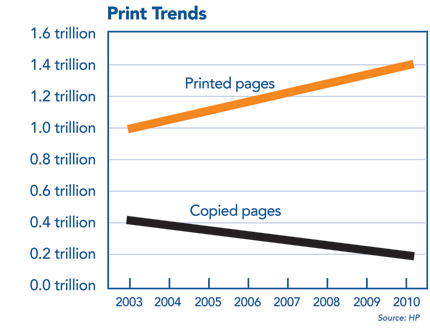Managing Print

Managed Print
- Unmanaged Print = Unmanaged Expense
- Runaway Printers and Pages
- Too Many Vendors, Makes and Models
- Printers vs. Copiers? Who Decides?
- Print vs. Copy - What’s going on?
- Too Many People, Too Much Time
- Why is Print Unmanaged?
Unmanaged Print = Unmanaged Expense
The vast majority of companies today have no idea what they are spending on office printing. Office printing costs are the largest unmanaged expense in business today. Does it matter? According to industry experts (below), these costs are significant and growing. So, yes, printing is a significant expenditure and for most companies it’s increasing. There are two reasons for this: First, the astronomical growth in information and easy access to this information via the internet is fueling printing. Second, users increasingly want to their documents printed in color. While the cost to print in color is going down, it is still 5 - 10 times more expensive to print in color than in black and white. To complicate matters, overall printing costs are difficult to quantify, since the cost of supplies, equipment and support are often buried in different cost centers across the organization.
"As much as 1-3 percent of your corporate revenues are spent on printing costs."
-Gartner Group
"The average employee prints 12,000 pages annually and can cost a business as much as $1,000 a person in toner."
-Cap Ventures
"Office printing trends show a 10-15 percent increase in printed pages annually."
-Helwett Packard
Runaway Printers and Pages
Most businesses don’t know the number of printers they have or the number pages they’re printing. Printers are easily bought and deployed, often without consideration to the capacity of the existing fleet. Typically, printers are rarely placed in an effort to balance print volumes with the printer’s capacity. All of this leads to an ever increasing cost of printing.
"Ninety percent of businesses do not know how much money they are spending on printing."
-Buyers Laboratory Inc. ![]()
Too Many Vendors, Makes and Models
It is quite common for printers to be purchased ad hoc by individual employees from different departments out of their own budgets. This results in an explosion of printers, many of which are locally connected and out of sight from management. This decentralized approach to purchasing printers results in multiple makes and models from multiple manufacturers. To further complicate matters, the printer manufacturers are constantly refreshing their printer offerings, making it difficult for companies to standardize on a set of print devices over any extended period of time. The cost of managing a printer fleet grows as the number of vendors, makes, models and toner cartridges grow. ![]()
Printers vs. Copiers - Who Decides?
Historically, print and copier vendors work with different departments within a company. For example, the facilities manager may be responsible for the copiers, while the IT manager is responsible for the printers. As a result, purchases of printers, supplies and service requests are often uncoordinated and made without considering the company’s overall needs.
The result of uncoordinated purchasing of print devices is duplication of technology within the printer fleet, and often more equipment than is required to support the user community. ![]()

Print vs. Copy - What’s going on?
In today’s business environment, most businesses print more than they copy. This means the vast majority of print devices are printers as opposed to copiers, fax machines or scanners As evidence of this trend, HP notes that print volume surpassed copy volume in 1995 and is growing at 10-15% each year ![]()
Too Many People, Too Much Time
Multiple departments within a company are usually involved in supporting the printer fleet in some capacity, including: IT, Office Services, Procurement and Finance. The time spent by these employees can be significant in acquiring print devices, managing supplies, maintaining print devices, troubleshooting print problems, replacing cartridges or parts, and processing invoices.
"As much as 50 percent of all help-desk calls are printer related."
-Gartner Group
"The total time required to complete the replacement of a single cartridge (from ordering, inventory management, replacement and disposal) is 23 minutes."
-Gartner Group ![]()
Why is Print Unmanaged?
Why are printers not managed? Typically, decisions pertaining to printers are made in "silos". Office services handles the copiers, procurement may be responsible for printing supplies, while IT buys the printers and is in charge of supporting the printer fleet. Different departments all have a say but there is no single department 100% responsible for the printer budget. Another reason is the sheer complexity of managing all the different printer devices and supply SKUs. It’s a logistical nightmare. ![]()